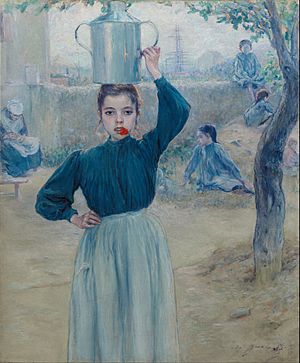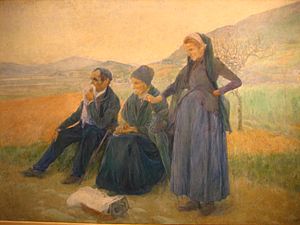Adolfo Guiard facts for kids
Adolfo Guiard Larrauri (born August 10, 1860 – died March 8, 1916) was a Spanish painter. He is known for his beautiful paintings in the Impressionist style. Impressionism is a way of painting that tries to capture the feeling of a moment, often using small, thin brushstrokes and focusing on light and color.
Contents
Biography
Early Life and Art Lessons
Adolfo Guiard was born in Bilbao, Spain, in 1860. He was one of fifteen children! His father, Alphonse Guiard, was a photographer from France. The family was quite well-off. However, they faced tough times when his father's photography studio burned down. This happened because of shelling during the Third Carlist War.
A writer named Nicolás de Viar y Egusquiza shared a story. He said his mother gave Adolfo his very first set of watercolors. This gift helped start Adolfo's amazing art career. His first official art lessons were with Antonio Lecuona. Lecuona was a well-known painter who focused on everyday life and customs (this style is called costumbrismo). When Adolfo was sixteen, he moved to Barcelona. There, he continued his art studies with Ramon Martí Alsina.
Studying in Paris
In 1878, Adolfo traveled to Paris, France. This was a big step for his art education. He was able to join the Académie Colarossi, a famous art school. He studied there with a teacher named Léon Glaize. Glaize was very impressed with Adolfo, saying he was a "born painter."
While in Paris, Adolfo also met other famous artists. One important artist he met was Degas. Degas had a major influence on Adolfo's painting style.
Returning Home and Gaining Fame
Around 1886, Adolfo Guiard returned to Bilbao. The next year, he received a very important job. He was asked by the Sociedad Bilbaína to decorate their main building. To work on this big project, he set up a studio in Bakio. He also had his first solo art show that same year.
At first, many art critics didn't like his work. However, a famous writer named Miguel de Unamuno praised his paintings.
In 1890, Adolfo moved to Murueta. There, he focused mostly on painting landscapes. Around 1900, he lived for a short time in Deustu. He also took part in the first exhibition of modern art held in Bilbao. This helped make his work more popular, even though some critics still didn't like it.
He finally settled in Artea. There, he shared an art studio with Anselmo Guinea. In 1902, his paintings were shown in Paris again. This time, they were part of an exhibition with other Spanish artists at the Silberberg Galleries.
Later Years
In 1908, Adolfo started writing for a funny magazine called El Coitao. This magazine also featured articles from other artists and writers. Some of them were young, like Tomás Meabe and José Arrue, and some were older, like Unamuno.
Three years later, he began showing his art with the new Basque Artists' Association. However, he never officially became a member of the group. In his final years, Adolfo painted much less. He passed away in Bilbao at the age of 56.
After his death, several large art shows celebrated his work. These were held in 1916, 1927, and more recently in 1984 at the Bilbao Fine Arts Museum. Most of his paintings are now owned by private collectors.
See also
 In Spanish: Adolfo Guiard para niños
In Spanish: Adolfo Guiard para niños




